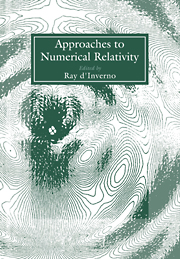Book contents
- Frontmatter
- Contents
- Contributors
- Introduction
- Preface
- PART A THEORETICAL APPROACHES
- PART B PRACTICAL APPROACHES
- Numerical asymptotics
- Instabilities in rapidly rotating polytropes
- Gravitational radiation from coalescing binary neutron stars
- “Critical” behaviour in massless scalar field collapse
- Godunov-type methods applied to general relativistic stellar collapse
- Astrophysical sources of gravitational waves and neutrinos
- Gravitational radiation from 3D gravitational stellar core collapse
- A vacuum fully relativistic 3D numerical code
- Solution of elliptic equations in numerical relativity using multiquadrics
- Self-gravitating thin discs around rotating black holes
- An ADI scheme for a black hole problem
- Time-symmetric ADI and causal reconnection
- The numerical study of topological defects
- Computations of bubble growth during the cosmological quark-hadron transition
- Initial data of axisymmetric gravitational waves with a cosmological constant
- PANEL DISCUSSION
Time-symmetric ADI and causal reconnection
Published online by Cambridge University Press: 15 December 2009
- Frontmatter
- Contents
- Contributors
- Introduction
- Preface
- PART A THEORETICAL APPROACHES
- PART B PRACTICAL APPROACHES
- Numerical asymptotics
- Instabilities in rapidly rotating polytropes
- Gravitational radiation from coalescing binary neutron stars
- “Critical” behaviour in massless scalar field collapse
- Godunov-type methods applied to general relativistic stellar collapse
- Astrophysical sources of gravitational waves and neutrinos
- Gravitational radiation from 3D gravitational stellar core collapse
- A vacuum fully relativistic 3D numerical code
- Solution of elliptic equations in numerical relativity using multiquadrics
- Self-gravitating thin discs around rotating black holes
- An ADI scheme for a black hole problem
- Time-symmetric ADI and causal reconnection
- The numerical study of topological defects
- Computations of bubble growth during the cosmological quark-hadron transition
- Initial data of axisymmetric gravitational waves with a cosmological constant
- PANEL DISCUSSION
Summary
Abstract. We study the effect of a moving grid on the stability of the finite difference approximations to the wave equation. We introduce two techniques, which we call “causal reconnection” and “time-symmetric ADI” that together provide efficient, accurate and stable integration schemes for all grid velocities in any number of dimensions.
INTRODUCTION
In the numerical study of wave phenomena it is often necessary to use a reference frame that is moving with respect to the medium in which the waves propagate. In this paper, by studying the simple wave equation, we show that the consistent application to such a problem of two fundamental physical principles — causality and time-reversal-invariance — produces remarkably stable, efficient and accurate integration methods.
Our principal motivation for studying these techniques is the development of algorithms for the numerical simulation of moving, interacting black-holes. If we imagine a black hole moving “through” a finite difference grid then some requirements become clear. As the hole moves, grid points ahead of it will fall inside the horizon, while others will emerge on the other side. This requires grids that shift faster than light. Moreover, in situations when the dynamical time scale is large, one would like to be free of the Courant stability condition on time-steps, i.e. one wants to use implicit methods. Full implicit schemes require the inversion of huge sparse matrices. Alternating Direction Implicit (ADI) schemes reduce the computational burden by turning the integration into a succession of one-dimensional implicit integrations.
- Type
- Chapter
- Information
- Approaches to Numerical Relativity , pp. 297 - 307Publisher: Cambridge University PressPrint publication year: 1992
- 1
- Cited by



